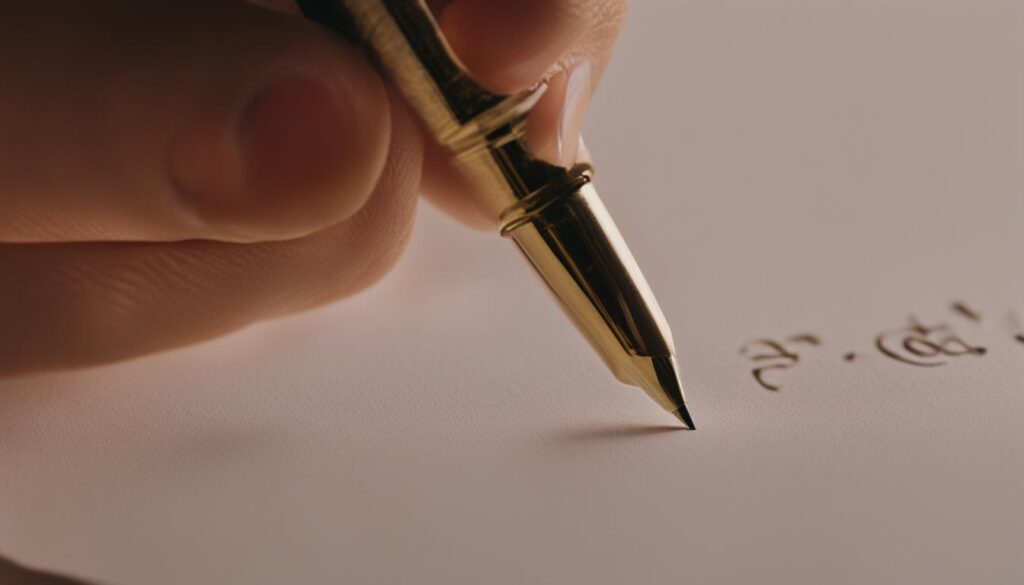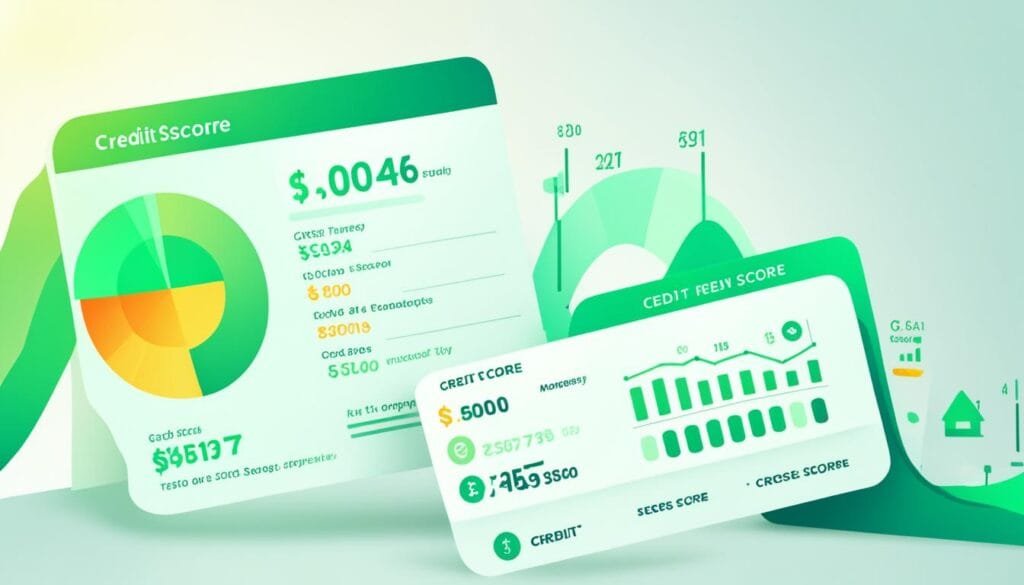Imagine this scenario: You’ve been diligently working to improve your credit score, making on-time payments and managing your finances responsibly. However, a few years ago, you went through a tough financial period that resulted in a late payment to one of your creditors. Despite your best efforts, the negative mark from that late payment still lingers on your credit reports, impacting your credit history and making it harder for you to secure loans or favorable interest rates.
But there is hope. Goodwill letters for credit repair can be a powerful tool in your arsenal to remove negative items from your credit history. With a well-crafted goodwill letter, you have the opportunity to reach out to your creditor, explain the circumstances of your late payment, and ask for their understanding and forgiveness. By doing so, you may be able to convince them to contact the credit bureaus and request the removal of that negative mark.
Key Takeaways:
- Goodwill letters are a potential way to remove negative items from your credit history.
- They involve reaching out to your creditor, explaining the circumstances, and asking for their understanding and forgiveness.
- Creditors are not obligated to consider your request, but it’s worth giving it a try.
- The effectiveness of goodwill letters varies, but they can have a significant impact on your credit score if successful.
- Managing your credit proactively and avoiding negative items in the future is crucial.
What is a Goodwill Letter?
A goodwill letter is a written request to a creditor or collection agency asking them to remove a negative mark from your credit reports. Unlike disputes, which involve contacting the credit bureaus about inaccurate information, goodwill letters are specifically directed to the original creditor or collection agency. In the letter, you acknowledge the mistake or misstep that led to the negative mark and ask for forgiveness and a “goodwill adjustment.”
When to Consider Using a Goodwill Letter
Goodwill letters can be a powerful tool in credit repair, but they are most effective in specific circumstances. If you have a good track record of making on-time payments and only have a few negative marks on your credit report, a goodwill letter may be worth considering. It is important to understand when it is appropriate to use a goodwill letter to address late payments, missed payments, or financial hardships.
If you have experienced a financial hardship, such as the loss of a job or a medical emergency, a goodwill letter can be a valuable option. It allows you to explain the circumstances that led to the late or missed payment and request leniency from your creditor.
In situations where a late or missed payment was due to a technical glitch or a change of address, a goodwill letter can help rectify the issue. These instances may involve genuine oversight or unforeseen circumstances, and a goodwill letter provides an opportunity to explain and apologize for the mistake.
It is important to be honest and genuine in your goodwill letter, explaining your situation clearly and concisely. Showing remorse for the late or missed payment and indicating the steps you have taken to prevent it from happening again can significantly increase the chances of a positive response from your creditor.
Important Considerations:
- Goodwill letters should only be used when you have a relatively good credit history with a few negative marks.
- Financial hardships, technical glitches, and address changes are valid reasons to consider using a goodwill letter.
- Be transparent, sincere, and concise in your letter, expressing regret for the late or missed payment.
- Highlight the actions you have taken to prevent similar incidents in the future.
Keep in mind that there is no guarantee that a goodwill letter will result in the removal of the negative mark from your credit report. Creditors are not obligated to honor or respond to goodwill letters, and some may have policies in place that restrict them from removing such marks. However, it is always worth trying, as a successful goodwill letter can significantly improve your credit history and increase your credit score.
How to Write a Goodwill Letter
When it comes to writing a goodwill letter, it’s crucial to maintain a professional and sincere tone while keeping the message concise. Remember to include essential details such as your account number and address, as well as provide a brief explanation of the situation that resulted in the negative mark on your credit report.
Express genuine regret for the mistake and outline the preventive measures you have taken to ensure it does not happen again in the future. It is also important to make a specific request for a “goodwill adjustment” from the creditor or collection agency, emphasizing your desire for a mutually beneficial solution.
Supporting evidence can significantly strengthen your case, so consider attaching relevant documents like medical bills or proof of a change in address. These materials demonstrate the legitimacy of your request and provide additional credibility to your goodwill letter.
Personalization is key in creating an impactful goodwill letter. Take the time to address the letter to the right individual or department within the creditor or collection agency. This attention to detail shows that you value the business relationship and are genuinely seeking a resolution. Additionally, expressing gratitude for the time and consideration given to your request can further enhance the overall effectiveness of the letter.
Goodwill Letter Template
Use the following template as a starting point for your goodwill letter:
Dear [Creditor’s Name/Collection Agency’s Name],
I am writing to request a goodwill adjustment regarding the negative mark on my credit reports. I sincerely regret the circumstances that led to this negative mark, and I would like to take this opportunity to provide further context and seek an understanding from your organization.
[Briefly explain the situation that caused the negative mark and express remorse for the mistake.]
I want to assure you that I have taken immediate steps to rectify the issue, and I am committed to ensuring that such an oversight does not occur again in the future. [Mention any specific actions taken to address the situation.]
Based on my otherwise strong credit history and ongoing positive relationship with your organization, I kindly request your consideration for a goodwill adjustment on my credit reports.
[Include any supporting evidence, such as medical bills or proof of a change in address.]
I greatly appreciate the attention given to this matter and the opportunity to resolve it amicably. Thank you for your time, understanding, and continued partnership.
Sincerely,
[Your Name]
[Your Address]
[City, State, ZIP]
[Email Address]
[Phone Number]
Examples of Successful Goodwill Letters
| Date | Recipient | Outcome |
|---|---|---|
| May 15, 2022 | ABC Bank | Goodwill adjustment approved. Negative mark removed from credit reports |
| June 20, 2022 | XYZ Collections | Goodwill adjustment denied. No change to negative mark on credit reports |
| July 5, 2022 | 123 Credit Agency | Goodwill adjustment approved. Partial removal of negative mark from credit reports |
These examples provide insight into the varying outcomes of goodwill letters. Remember, results are not guaranteed, and each situation is unique. Goodwill letters are just one tool in the credit repair process, and exploring other avenues may be necessary for achieving your desired results.

Limitations and Potential Benefits of Goodwill Letters
When it comes to using goodwill letters as a tool for credit repair, it’s important to understand the limitations and potential benefits involved. While goodwill letters have the potential to help improve your credit score by removing negative items, there are no guarantees of success. Creditors are not obligated to honor or respond to goodwill letters, and some may have policies or agreements with credit bureaus that prevent them from removing negative items.
However, if a goodwill letter is successful, it can have significant benefits for your credit history. By removing a negative mark from your credit reports, you can potentially save yourself from years of credit difficulties. It’s important to approach goodwill letters with realistic expectations and understand that their effectiveness can vary depending on the creditor and the specific circumstances.
Here are some key points to consider regarding the limitations and potential benefits of goodwill letters:
- There is no guarantee of success: Creditors are not required to honor or respond to goodwill letters.
- Policies and agreements: Some creditors may have internal policies or agreements with credit bureaus that prevent them from removing negative items.
- Effectiveness can vary: The success of a goodwill letter depends on various factors, such as the creditor’s willingness to grant a “goodwill adjustment” and the nature of the negative mark.
Despite these limitations, a successful goodwill letter can make a positive impact on your credit score and overall credit history. It’s important to approach the process with patience, persistence, and a proactive mindset.
Are Goodwill Letters a Good Strategy for Building Credit from Scratch?
Goodwill letters can be a helpful strategy for building credit from scratch. These letters involve reaching out to creditors and asking for a one-time removal of a missed payment from your credit report. If successful, it can improve your credit score and demonstrate responsible financial behavior.
Conclusion
Goodwill letters can be a powerful tool in the process of credit repair. They provide an avenue for individuals who have made a one-time mistake resulting in a negative mark on their credit reports to seek forgiveness and potential removal of that mark. While success is not guaranteed with goodwill letters, it is certainly worth trying, especially if you have a good relationship with your creditor and can provide a reasonable explanation for the negative mark.
However, it is important to remember that goodwill letters are just one piece of the puzzle. To truly improve your credit history, it is essential to take a proactive approach in managing your credit. This means making consistent, on-time payments, keeping your credit utilization low, and avoiding any actions that could result in negative items on your credit reports.
By effectively utilizing goodwill letters and implementing sound financial practices, you can work towards repairing your credit and achieving your financial goals. Remember, credit repair takes time and effort, so it’s important to stay dedicated and patient throughout the process.
FAQ
What is a goodwill letter?
A goodwill letter is a written request to a creditor or collection agency asking them to remove a negative mark from your credit reports. It is a way to show mercy and request forgiveness for a mistake or misstep that led to the negative mark.
When should I consider using a goodwill letter?
You should consider using a goodwill letter if you have a good track record of making on-time payments and only have a few negative marks on your credit report. This may be especially applicable if you have experienced a financial hardship or missed a payment due to a technical glitch or change of address.
How do I write a goodwill letter?
When writing a goodwill letter, be professional, sincere, and concise. Include your account number, address, and a brief explanation of the situation that led to the negative mark. Express regret for the mistake and outline the steps you have taken to prevent it from happening again. Make a specific request for a “goodwill adjustment” and provide any supporting evidence. Personalize the letter and show gratitude for the business relationship.
What are the limitations and potential benefits of goodwill letters?
It’s important to manage expectations when it comes to goodwill letters. Creditors are not required to honor or respond to them, and there is no guarantee of success. However, if a goodwill letter is successful, it can help improve your credit score by removing a negative mark and potentially saving you years of credit difficulties.
What is the purpose of a goodwill letter?
The purpose of a goodwill letter is to request the removal of a legitimate negative mark from your credit reports. By acknowledging your mistake, expressing remorse, and asking for forgiveness, you hope to secure a “goodwill adjustment” that improves your credit history.

